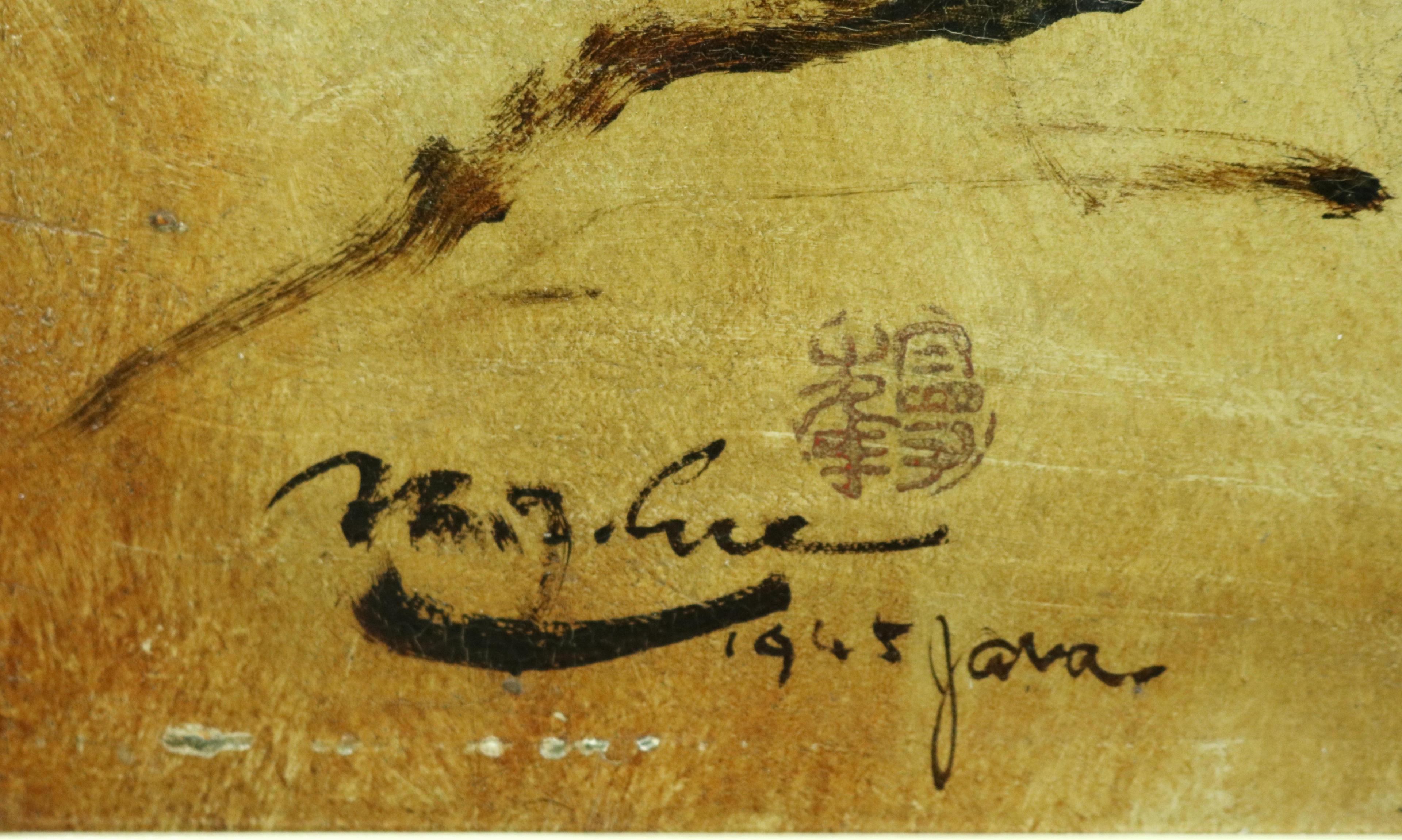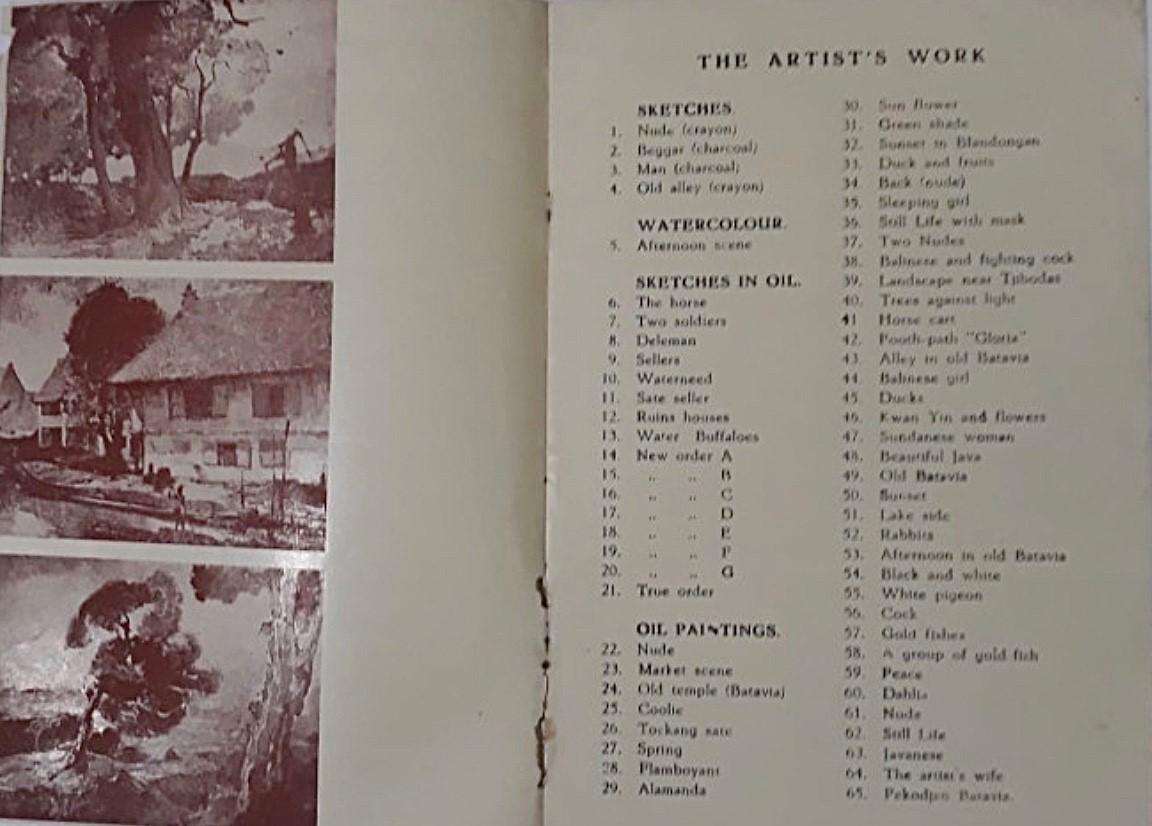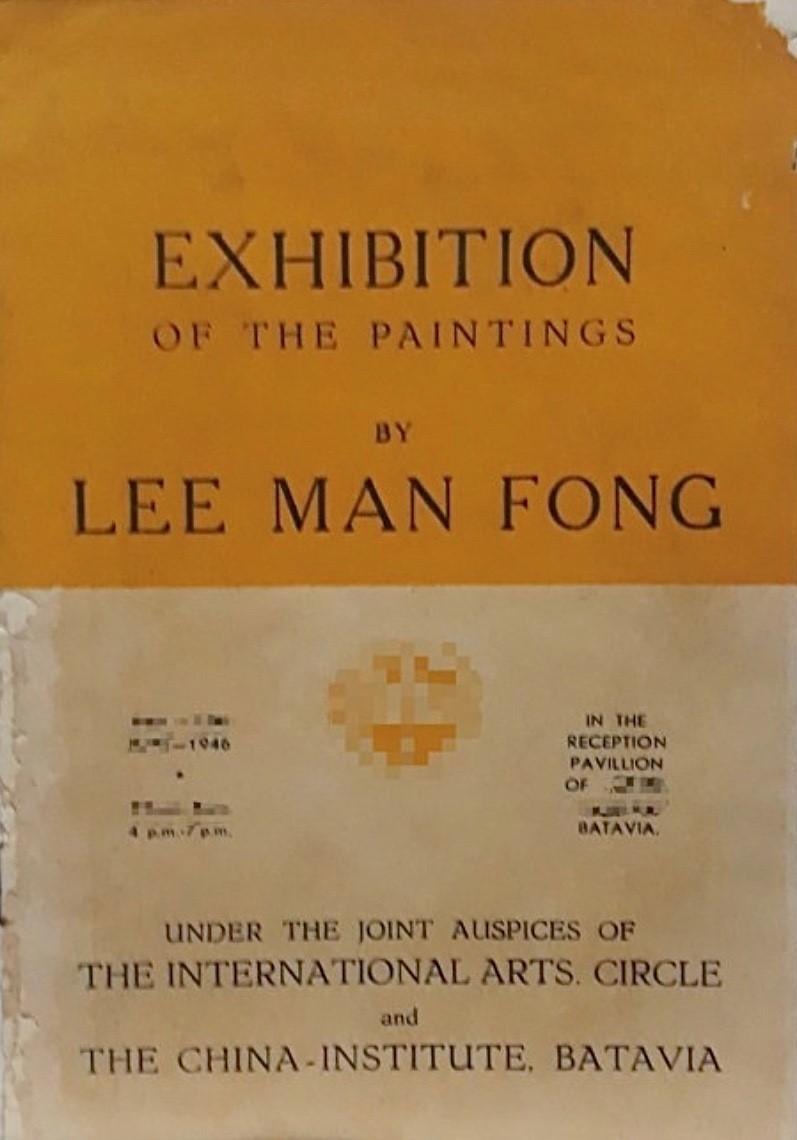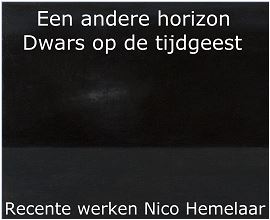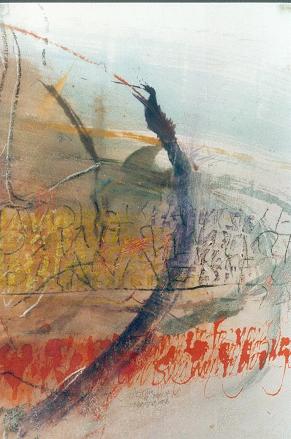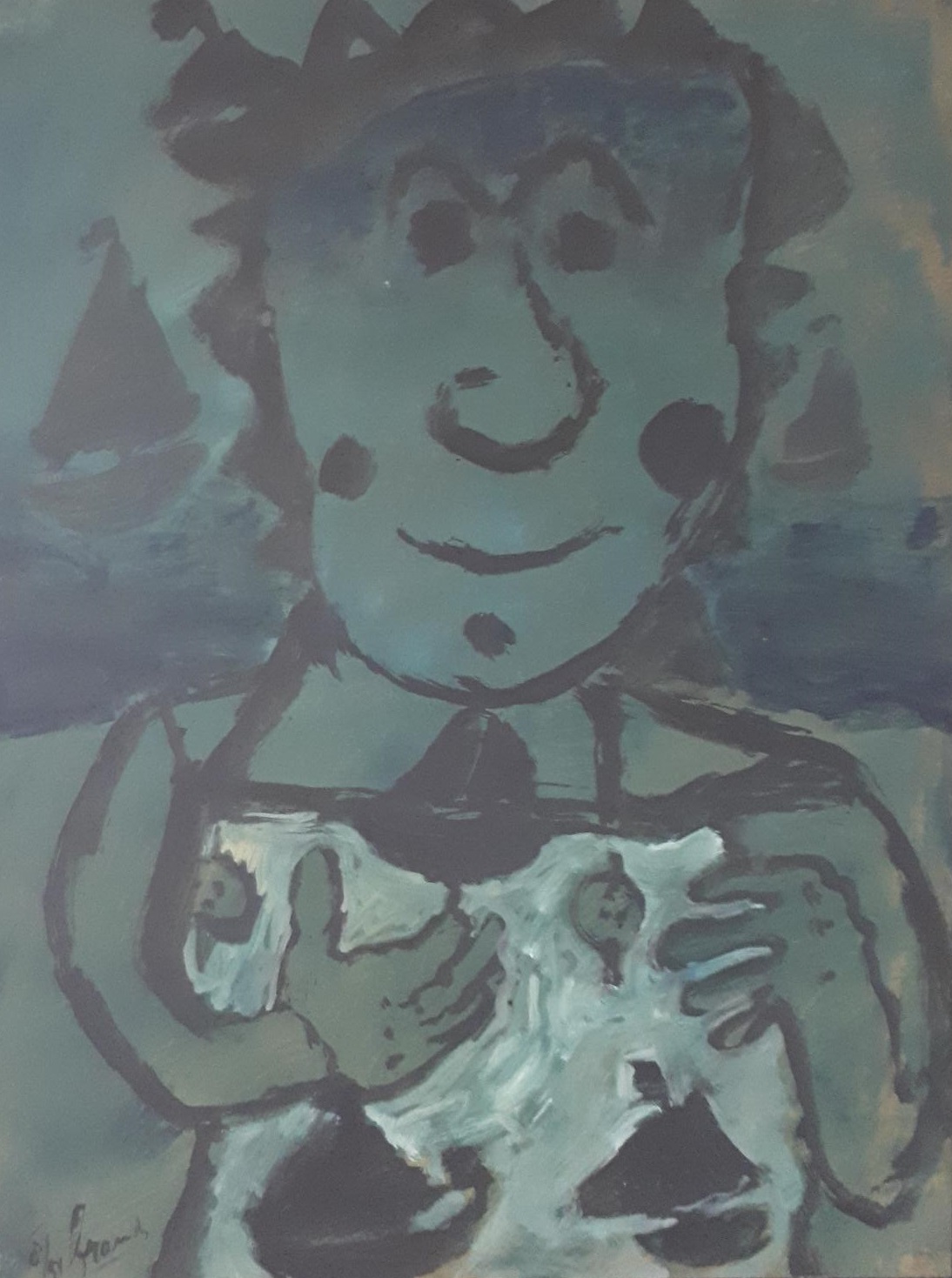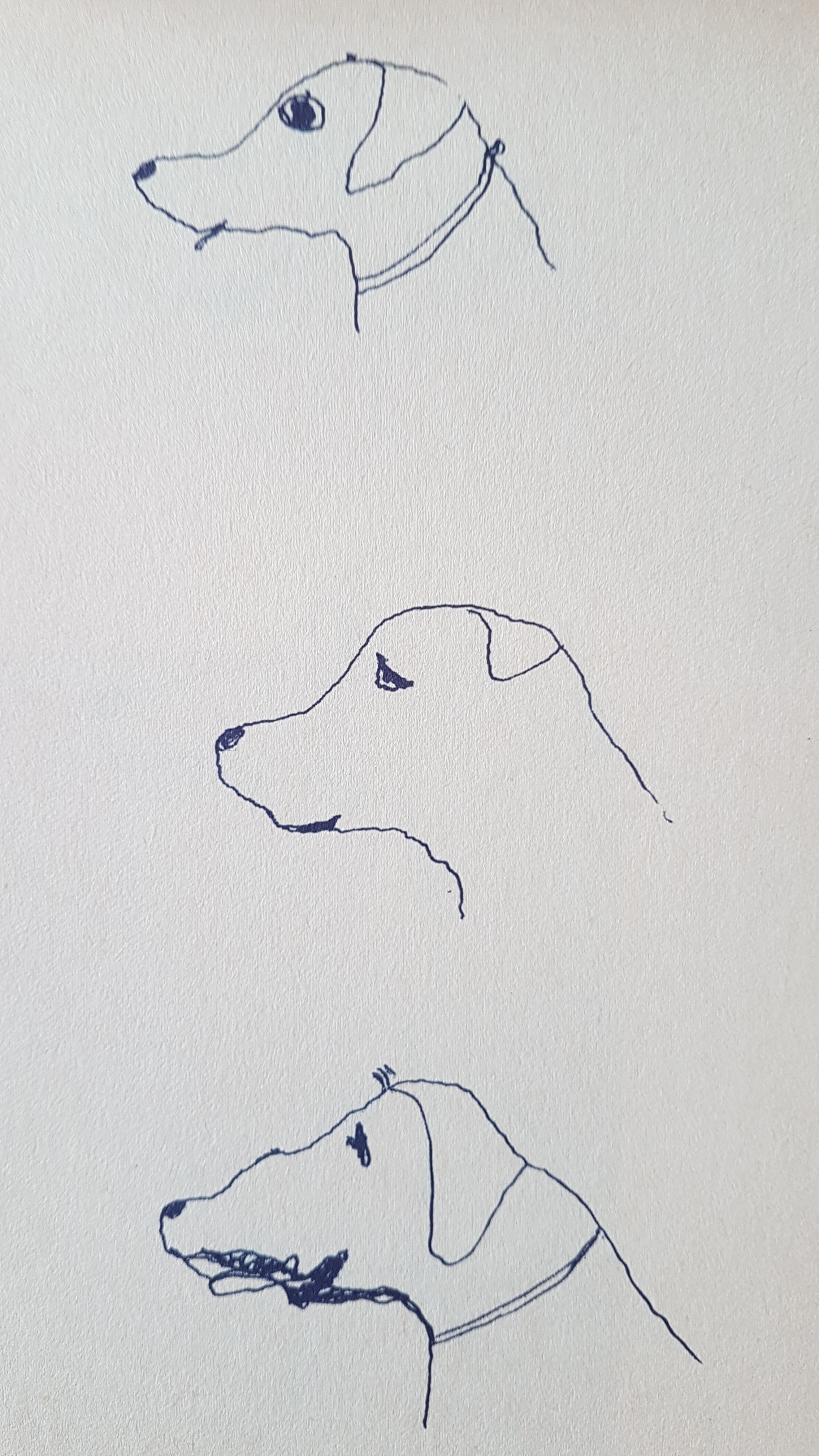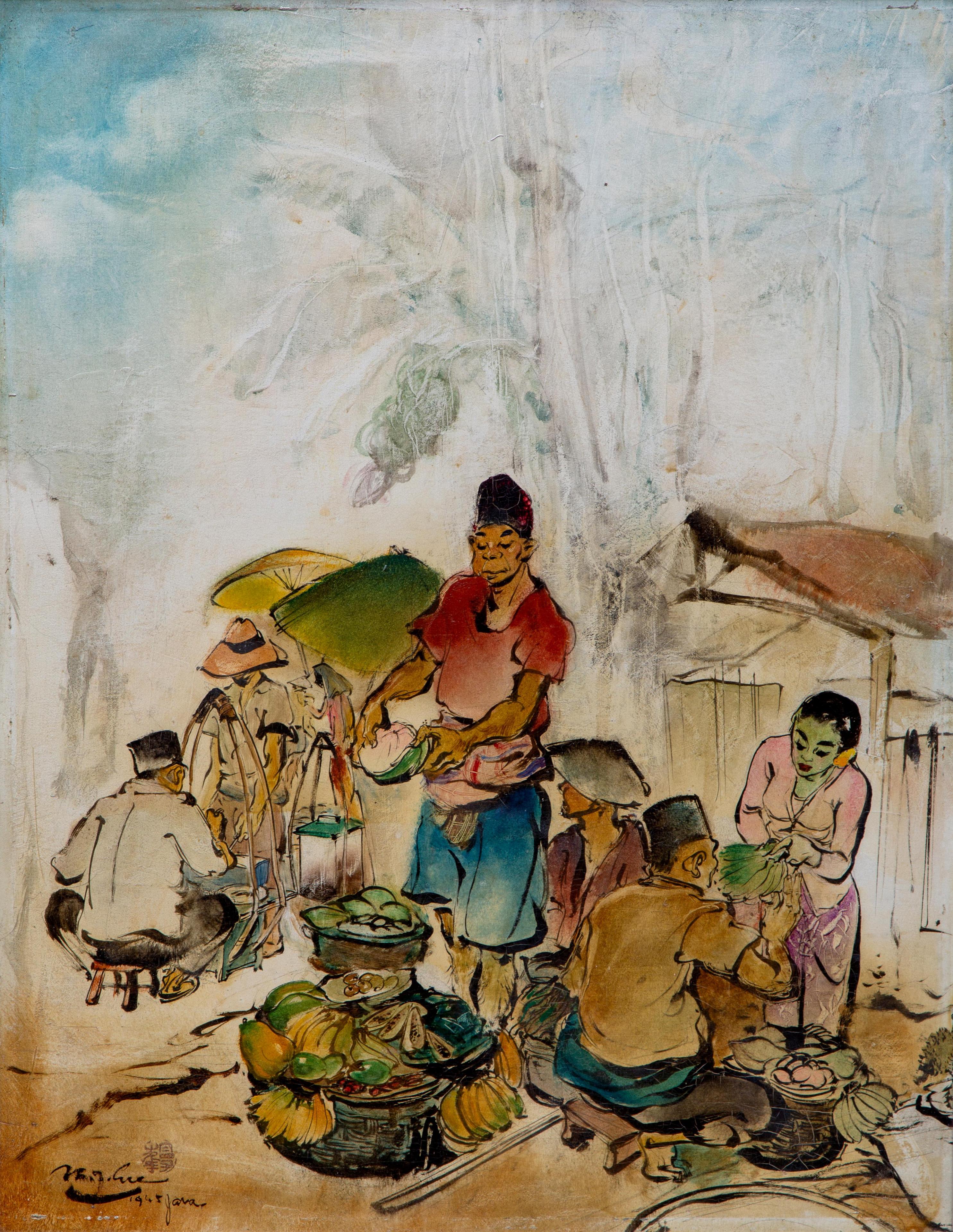
Beschrijving
Stamped and signed 'M F Lee' and dated and annotated '1945 Java' (lower left); annotated and dated 'Batavia 26 juni 1945' (on the reverse). Provenance: -Former collection Arie Bakker (1914-1992), thence by descent to the present owner.
Arie Bakker left the Netherlands with his first wife Evy Beer, at the end of the Second World War and went to the Netherlands-Indies, later the Republic of Indonesia. As a civil engineer he was appointed Head of the office dams and hydrology. He lived from 1945 to 1952 in various places, including Bandung and on Celebes. The couple were always interested in art and during that time purchased this painting.
The present lot, dated 1945, was likely purchased at the Lee Man Fong solo exhibition Batavia, June 1946 (see provenance research below). It shows a rather busy market scene, with three sellers, two buyers and two spectators, which forms a composition of warm and intimate interactions. The focus of this painting is the very tall, standing fruit seller at the center who is peeling a large pinkish pomelo, wearing a red shirt and blue knee-length shorts. To his immediate right is a seated man with a hat. Further to the right is a rather short female seller conversing with the seated man and bargaining over a bunch of green bananas. To the left is a food vendor and his customer, who is seated and eating his meal.
What’s remarkable about the present lot is the juxtaposition of full, lively and colorful composition in the foreground with a very simple, even unfinished appearing, background that helps to create an airy atmosphere that complements the dynamics of the market activity.
Works created during the revolutionary War of Independence of Indonesia (1945-1949), were often destroyed and are therefore quite rare. The present lot has been in the family of Arie Bakker since it was purchased in 1946. This presents a unique opportunity to own one of the gems of Lee Man Fong’s works, which has come fresh to the market and may not appear again for a long time.
Provenance Research
This painting was acquired in Indonesia between 1945-1952, during the time that the original owner, Mr. Arie Bakker and his wife lived in Indonesia. Arie Bakker (1914 – 1992) worked in Indonesia as a civil engineer, and lived in Java and Celebes. He was the head of the Bureau for Dams and Hydrology from 1945 – 1952.
Lee Man Fong (1913 – 1988) was born in Guangdong, China and was brought to Singapore when he was only 3 years old. By 1929, he was already fluent in oil painting and produced the work “Shuanglin Temple” (1929), which demonstrated his talent in blending Chinese techniques with western composition and media (oil on canvas / board). He was trained by Huang Qingquan of the Nanyang School.
After the death of his father in 1930, he moved to Indonesia (1932). Initially, he worked as the art editor for the Chinese paper, Shibao and later moved on to work as a graphic designer for the Dutch publisher, Kolff. His talent was recognized at his first exhibition in 1936, when the Dutch Governor General, B.C. de Jonge, acquired one of his paintings. By 1941 he decided to end his advertising career and became a professional artist. Soon thereafter, he spent 3 months working in Bali and organized his first solo exhibition in Batavia (Jakarta). He was interned for 6 months during the Japanese Occupation and during that period he met Soekarno, the young Javanese activist, who later became the first president of Indonesia.
It was in June 1946, that Lee Man Fong had his second solo exhibition in Batavia, at the Hotel des Indes, co-sponsored by the International Arts Circle and the China-Institute Batavia. The exhibition was accompanied by a short catalogue, about 10 pages (see Fig. 1).
In the closing of his introductory remarks, dated 10 May 1945, for the exhibition catalogue, Prof. C.P. Wolff Schoemaker had high praise and expectations for the young Lee Man Fong:
“Incidentally I want to express my enthusiasm and my high-pitched expectations with regard to the development of this sympathetic young master. In my opinion his potentialities in art do not only mark wide prospects for himself but [at] the same time indicate the virtual power in artistic conception of ingenious Chinese in general.”
It is very likely that Arie Bakker purchased Street life, Java painting during the 1946 exhibition at Hotel des Indes. On the list of artist’s works for that exhibition (see Fig. 2), there are two titles that could fit the description of the present painting: an 'Oil Painting' listed as market scene (#23) and an 'Oil Sketch Painting' listed as sellers (#9). Unfortunately, there are no dimensions given in the catalogue or further description of the paintings which could clarify. Since the current lot is not a sketch, it is more likely that this work is the #23 oil painting listed as “market scene” which is also the better description of the subject of this work. Note that soon after the 1946 solo exhibition, Lee Man Fong received the Malino Scholarship and moved to Holland where he lived from 1946-1952. This provides further evidence that Arie Bakker, who lived in Java from 1945-1952, bought the present lot at the 1946 Exhibition in Batavia before Lee Man Fong left for the Netherlands.
notes:
See Fiona Tan (2013), “Lee Man Fong”, https://eresources.nlb.gov.sg/infopedia/articles/SIP_2013-05-06_095744.html, retrieved on 3 October 2020.
As reported in “Schilderijententoonstelling”, Het dagblad; uitgave van de Nederlandsche Dagbladpers te Batavia 15 June 1946 p. 1
“Tentoonstelling Lee Man Fong” Het dagblad; uitgave van de Nederlandsche Dagbladpers te Batavia 19 June 1946 p. 2.
Figure 1. Catalogue cover of Lee Man Fong solo exhibition in Batavia from 17 to 23 June 1946
Figure 2. List of Lee Man Fong’s work.
Details
- Databanknummer:
- 85544
- Lotnummer:
- -
- Advertentietype
- Archief
- Instelling:
- Venduehuis Den Haag
- Veilingdatum:
- -
- Veilingnummer:
- -
- Stad
- -
- Limietprijs
- -
- Aankoopprijs
- -
- Verkoopprijs
- -
- Hamerprijs
- -
- Status
- Verkocht
Technische details
- Kunstvorm:
- Schilder- en Tekenkunst
- Technieken:
- Olieverf
- Dragers:
- Board
- Lengte:
- 66 cm
- Breedte:
- 51.5 cm
- Hoogte:
- -
- Oplage:
- -
Beschrijving
Stamped and signed 'M F Lee' and dated and annotated '1945 Java' (lower left); annotated and dated 'Batavia 26 juni 1945' (on the reverse). Provenance: -Former collection Arie Bakker (1914-1992), thence by descent to the present owner.
Arie Bakker left the Netherlands with his first wife Evy Beer, at the end of the Second World War and went to the Netherlands-Indies, later the Republic of Indonesia. As a civil engineer he was appointed Head of the office dams and hydrology. He lived from 1945 to 1952 in various places, including Bandung and on Celebes. The couple were always interested in art and during that time purchased this painting.
The present lot, dated 1945, was likely purchased at the Lee Man Fong solo exhibition Batavia, June 1946 (see provenance research below). It shows a rather busy market scene, with three sellers, two buyers and two spectators, which forms a composition of warm and intimate interactions. The focus of this painting is the very tall, standing fruit seller at the center who is peeling a large pinkish pomelo, wearing a red shirt and blue knee-length shorts. To his immediate right is a seated man with a hat. Further to the right is a rather short female seller conversing with the seated man and bargaining over a bunch of green bananas. To the left is a food vendor and his customer, who is seated and eating his meal.
What’s remarkable about the present lot is the juxtaposition of full, lively and colorful composition in the foreground with a very simple, even unfinished appearing, background that helps to create an airy atmosphere that complements the dynamics of the market activity.
Works created during the revolutionary War of Independence of Indonesia (1945-1949), were often destroyed and are therefore quite rare. The present lot has been in the family of Arie Bakker since it was purchased in 1946. This presents a unique opportunity to own one of the gems of Lee Man Fong’s works, which has come fresh to the market and may not appear again for a long time.
Provenance Research
This painting was acquired in Indonesia between 1945-1952, during the time that the original owner, Mr. Arie Bakker and his wife lived in Indonesia. Arie Bakker (1914 – 1992) worked in Indonesia as a civil engineer, and lived in Java and Celebes. He was the head of the Bureau for Dams and Hydrology from 1945 – 1952.
Lee Man Fong (1913 – 1988) was born in Guangdong, China and was brought to Singapore when he was only 3 years old. By 1929, he was already fluent in oil painting and produced the work “Shuanglin Temple” (1929), which demonstrated his talent in blending Chinese techniques with western composition and media (oil on canvas / board). He was trained by Huang Qingquan of the Nanyang School.
After the death of his father in 1930, he moved to Indonesia (1932). Initially, he worked as the art editor for the Chinese paper, Shibao and later moved on to work as a graphic designer for the Dutch publisher, Kolff. His talent was recognized at his first exhibition in 1936, when the Dutch Governor General, B.C. de Jonge, acquired one of his paintings. By 1941 he decided to end his advertising career and became a professional artist. Soon thereafter, he spent 3 months working in Bali and organized his first solo exhibition in Batavia (Jakarta). He was interned for 6 months during the Japanese Occupation and during that period he met Soekarno, the young Javanese activist, who later became the first president of Indonesia.
It was in June 1946, that Lee Man Fong had his second solo exhibition in Batavia, at the Hotel des Indes, co-sponsored by the International Arts Circle and the China-Institute Batavia. The exhibition was accompanied by a short catalogue, about 10 pages (see Fig. 1).
In the closing of his introductory remarks, dated 10 May 1945, for the exhibition catalogue, Prof. C.P. Wolff Schoemaker had high praise and expectations for the young Lee Man Fong:
“Incidentally I want to express my enthusiasm and my high-pitched expectations with regard to the development of this sympathetic young master. In my opinion his potentialities in art do not only mark wide prospects for himself but [at] the same time indicate the virtual power in artistic conception of ingenious Chinese in general.”
It is very likely that Arie Bakker purchased Street life, Java painting during the 1946 exhibition at Hotel des Indes. On the list of artist’s works for that exhibition (see Fig. 2), there are two titles that could fit the description of the present painting: an 'Oil Painting' listed as market scene (#23) and an 'Oil Sketch Painting' listed as sellers (#9). Unfortunately, there are no dimensions given in the catalogue or further description of the paintings which could clarify. Since the current lot is not a sketch, it is more likely that this work is the #23 oil painting listed as “market scene” which is also the better description of the subject of this work. Note that soon after the 1946 solo exhibition, Lee Man Fong received the Malino Scholarship and moved to Holland where he lived from 1946-1952. This provides further evidence that Arie Bakker, who lived in Java from 1945-1952, bought the present lot at the 1946 Exhibition in Batavia before Lee Man Fong left for the Netherlands.
notes:
See Fiona Tan (2013), “Lee Man Fong”, https://eresources.nlb.gov.sg/infopedia/articles/SIP_2013-05-06_095744.html, retrieved on 3 October 2020.
As reported in “Schilderijententoonstelling”, Het dagblad; uitgave van de Nederlandsche Dagbladpers te Batavia 15 June 1946 p. 1
“Tentoonstelling Lee Man Fong” Het dagblad; uitgave van de Nederlandsche Dagbladpers te Batavia 19 June 1946 p. 2.
Figure 1. Catalogue cover of Lee Man Fong solo exhibition in Batavia from 17 to 23 June 1946
Figure 2. List of Lee Man Fong’s work.
Aangeboden kunst
Een selectie uit ons kunstaanbod

